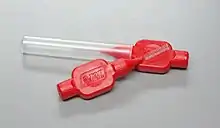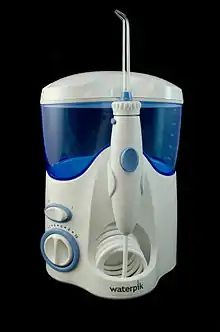Interdental cleaning
Interdental cleaning or interproximal cleaning is part of oral hygiene where the aim is to clean the areas in between the teeth, otherwise known as the proximal surfaces of teeth. This is to remove the dental plaque in areas a toothbrush cannot reach. The ultimate goal of interproximal cleaning is to prevent the development of interproximal caries and periodontal disease. The combined use of tooth brushing, and mechanical and manual interdental cleaning devices has been proven to reduce the prevalence of caries and periodontal diseases.[1][2]
Floss
.jpg.webp)
Floss is one of the most commonly used interdental cleaners. It is traditionally made of waxed nylon wrapped up in a plastic box. Since dental floss is able to remove some inter-proximal plaque, frequent regular dental flossing will reduce inter-proximal caries and periodontal disease risks.[1][3] Results of a high level of evidence meta-analysis recently found that floss may not be the most effective method for interdental cleaning, contrary to common belief at the time.[4] Especially for individuals lacking dexterity or compliance, waterjet irrigators, and interdental brushes were found to be significantly more effective than flossing.[4]
Interdental brush

Interdental brushes commonly consist of a central metal wire core with soft nylon filaments twisted around, and are available in various sizes to correspond to different spaces between teeth. Certain factors such as material, geometry and size of the brush can be chosen to optimize the efficiency and effectiveness:
- Material: metal wire may be sensitive to certain patients, thereby rubber might be preferred.
- Geometry: Straight interdental brushes are considered more effective compared to angled interproximal plaque removal.
- Size: This varies depending on the space between individual teeth. Failure to use an appropriate size may account for the lack of efficiency of interdental cleaning aid.[5]
Oral irrigator

Oral Irrigators (also called water flossers) are common mechanical tools used for interdental cleaning. It uses a combination of pulsation and pressure facilitated by water or air to remove debris and bacteria both above and below the gums.[6] When used with tooth brushing, the use of oral irrigators reduces inflammation of the gums (gingivitis) by removing loosely adherent plaque. It is also beneficial for implant maintenance as there is less bleeding around implants when oral irrigators are used compared to dental floss.[7][5]
Toothpick
Toothpicks are thin sticks made from various materials that insert into the interdental space for cleaning. Although there is a long history of use dating back to 1.8 million years ago,[8] dentists generally recommend against their use due to a perceived danger of causing mechanical damage to gum, enamel, and tooth roots.[9]
References
- Hujoel, P.P.; Cunha-Cruz, J.; Banting, D.W.; Loesche, W.J. (2006). "Dental Flossing and Interproximal Caries: a Systematic Review". Journal of Dental Research. 85 (4): 298–305. doi:10.1177/154405910608500404. ISSN 0022-0345. PMID 16567548. S2CID 53789465.
- Sambunjak, Dario; Nickerson, Jason W.; Poklepovic, Tina; Johnson, Trevor M.; Imai, Pauline; Tugwell, Peter; Worthington, Helen V. (2011-12-07). "Flossing for the management of periodontal diseases and dental caries in adults". The Cochrane Database of Systematic Reviews (12): CD008829. doi:10.1002/14651858.CD008829.pub2. ISSN 1469-493X. PMID 22161438.
- Bagramian, Robert A.; Garcia-Godoy, Franklin; Volpe, Anthony R. (2009). "The global increase in dental caries. A pending public health crisis". American Journal of Dentistry. 22 (1): 3–8. ISSN 0894-8275. PMID 19281105.
- Kotsakis, Georgios A.; Lian, Qinshu; Ioannou, Andreas L.; Michalowicz, Bryan S.; John, Mike T.; Chu, Haitao (2018). "A network meta-analysis of interproximal oral hygiene methods in the reduction of clinical indices of inflammation". Journal of Periodontology. 89 (5): 558–570. doi:10.1002/JPER.17-0368. ISSN 1943-3670. PMC 5984142. PMID 29520910.
- Ng, Ethan; Lim, Lum Peng (2019-06-01). "An Overview of Different Interdental Cleaning Aids and Their Effectiveness". Dentistry Journal. 7 (2): 56. doi:10.3390/dj7020056. ISSN 2304-6767. PMC 6630384. PMID 31159354.
- MS, AEGIS Communications, By Deborah M. Lyle, RDH, BS. "Use of a Water Flosser For Interdental Cleaning | Compendium". Dental Network. Retrieved 2023-05-10.
{{cite web}}: CS1 maint: multiple names: authors list (link) - Worthington, Helen V; MacDonald, Laura; Poklepovic Pericic, Tina; Sambunjak, Dario; Johnson, Trevor M; Imai, Pauline; Clarkson, Janet E (2019-04-10). "Home use of interdental cleaning devices, in addition to toothbrushing, for preventing and controlling periodontal diseases and dental caries". Cochrane Database of Systematic Reviews. 2020 (4): CD012018. doi:10.1002/14651858.cd012018.pub2. ISSN 1465-1858. PMC 6953268. PMID 30968949.
- Hogenboom, Melissa (8 October 2013). "'Ancient humans' used toothpicks". BBC News. Retrieved 29 August 2021.
- "But It's Just a Little Toothpick, How Threatening Can It Be". Northern Dental Design. 10 June 2021.